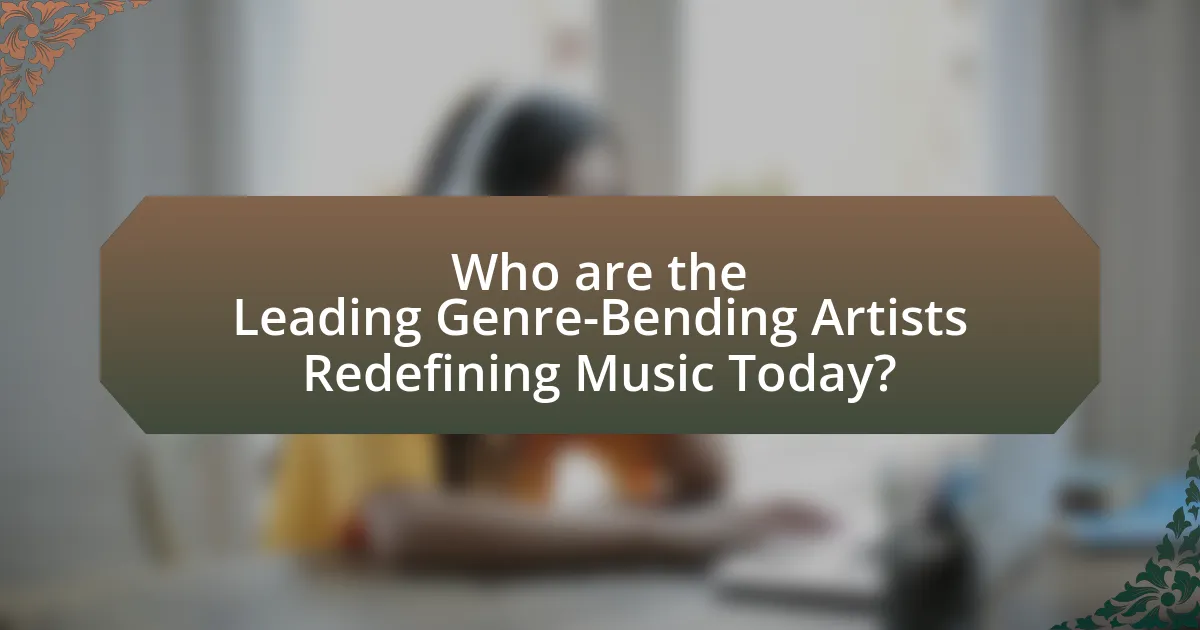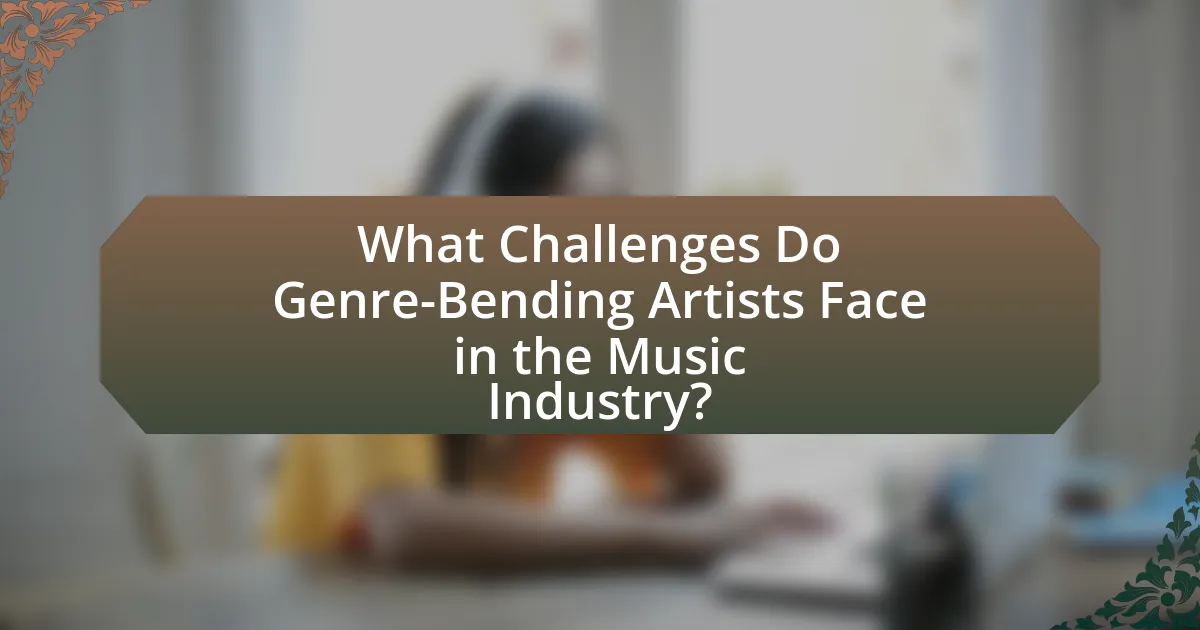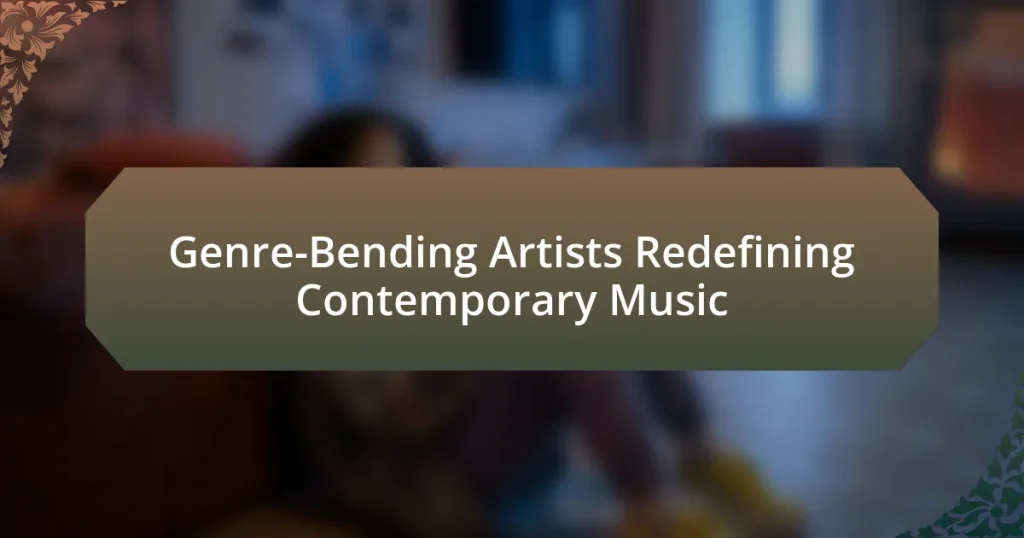Genre-bending artists are musicians who blend elements from multiple genres to create innovative sounds that challenge traditional classifications, significantly impacting contemporary music. This article explores how these artists, such as Billie Eilish and Lil Nas X, redefine genre boundaries, foster creativity, and attract diverse audiences. It examines the cultural shifts reflected in genre-bending music, the challenges these artists face in the industry, and the strategies they employ to maintain artistic integrity while achieving commercial success. Additionally, the article discusses future trends in genre-bending, including the influence of technology and emerging genres that may shape the next wave of musical innovation.

What are Genre-Bending Artists and Their Impact on Contemporary Music?
Genre-bending artists are musicians who blend elements from multiple musical genres to create innovative sounds that challenge traditional classifications. Their impact on contemporary music is significant, as they expand the boundaries of genre, foster creativity, and attract diverse audiences. For instance, artists like Billie Eilish combine pop, electronic, and indie influences, while Lil Nas X merges country and hip-hop, both achieving commercial success and critical acclaim. This genre fusion not only reflects cultural shifts but also encourages collaboration across musical styles, leading to a more inclusive and dynamic music landscape.
How do Genre-Bending Artists challenge traditional music boundaries?
Genre-bending artists challenge traditional music boundaries by blending elements from multiple genres to create innovative sounds that defy categorization. This fusion often results in new musical styles that incorporate diverse influences, such as hip-hop, rock, electronic, and jazz, allowing for greater artistic expression and audience engagement. For instance, artists like Billie Eilish and Lil Nas X have successfully merged pop with elements of alternative and country, respectively, demonstrating how genre fluidity can attract wider audiences and reshape industry standards. This approach not only expands the creative possibilities for musicians but also encourages listeners to embrace a more inclusive understanding of music, ultimately transforming the landscape of contemporary music.
What genres do these artists typically blend?
These artists typically blend genres such as pop, hip-hop, rock, electronic, and R&B. For instance, artists like Billie Eilish incorporate elements of pop and electronic music, while Lil Nas X merges country with hip-hop. This genre-blending reflects a broader trend in contemporary music where traditional boundaries are increasingly blurred, allowing for innovative sounds and diverse influences.
How does genre-bending influence listener perceptions?
Genre-bending influences listener perceptions by challenging traditional genre boundaries, leading to a broader understanding of music. This fusion of styles encourages listeners to engage with diverse musical elements, fostering openness to new experiences. Research indicates that genre-blending can enhance emotional responses and increase listener enjoyment, as seen in the works of artists like Billie Eilish and Lil Nas X, who incorporate multiple genres into their music. This approach not only attracts a wider audience but also reshapes cultural norms around music consumption, as listeners become more receptive to innovative sounds and cross-genre collaborations.
Why is genre-bending significant in today’s music landscape?
Genre-bending is significant in today’s music landscape because it fosters innovation and expands artistic expression. By blending elements from different genres, artists create unique sounds that challenge traditional boundaries, attracting diverse audiences. For instance, the rise of artists like Lil Nas X, who combines country and hip-hop, demonstrates how genre-bending can lead to mainstream success and cultural conversations. This trend reflects a broader shift in consumer preferences, with a 2021 report from the International Federation of the Phonographic Industry indicating that 75% of music listeners enjoy a mix of genres, highlighting the demand for varied musical experiences.
What cultural shifts are reflected in genre-bending music?
Genre-bending music reflects significant cultural shifts towards inclusivity, diversity, and the breaking down of traditional genre barriers. This evolution is evident as artists blend elements from various musical styles, such as hip-hop, rock, electronic, and pop, creating hybrid sounds that resonate with a broader audience. For instance, the rise of artists like Lil Nas X, who combines country and rap, illustrates how genre-bending challenges societal norms and embraces multicultural influences. Additionally, the increasing acceptance of genre fluidity in music mirrors broader societal movements advocating for identity exploration and self-expression, as seen in the popularity of LGBTQ+ artists and themes. This shift is further supported by data showing that streaming platforms have facilitated the discovery of diverse music, allowing listeners to engage with a wider array of genres and artists, thus reinforcing the cultural significance of genre-bending in contemporary society.
How does genre-bending contribute to musical innovation?
Genre-bending contributes to musical innovation by merging diverse musical styles, which fosters creativity and expands the boundaries of traditional genres. This blending allows artists to experiment with new sounds, techniques, and cultural influences, resulting in unique compositions that challenge conventional norms. For instance, artists like Billie Eilish and Lil Nas X have successfully combined elements from pop, hip-hop, and electronic music, leading to chart-topping hits that redefine genre expectations. The Billboard Hot 100 has seen an increase in genre-blending tracks, illustrating a shift in listener preferences towards more eclectic sounds. This evolution not only reflects changing cultural landscapes but also encourages other musicians to explore and innovate, further driving the evolution of contemporary music.

Who are the Leading Genre-Bending Artists Redefining Music Today?
Leading genre-bending artists redefining music today include Billie Eilish, Lil Nas X, and Anderson .Paak. Billie Eilish blends pop, electronic, and alternative influences, achieving critical acclaim with her unique sound and innovative production techniques. Lil Nas X gained fame for merging country and hip-hop, particularly with his hit “Old Town Road,” which broke genre barriers and topped charts. Anderson .Paak combines elements of R&B, hip-hop, and funk, showcasing his versatility as both a vocalist and instrumentalist. These artists exemplify the current trend of genre fluidity in contemporary music, pushing boundaries and expanding the definitions of musical genres.
What are some notable examples of genre-bending artists?
Notable examples of genre-bending artists include Billie Eilish, who blends pop, electronic, and alternative influences, and Lil Nas X, known for merging country and hip-hop in his music. Eilish’s debut album “When We All Fall Asleep, Where Do We Go?” showcases her unique sound, which defies traditional pop conventions. Lil Nas X’s hit “Old Town Road” gained widespread acclaim for its innovative fusion of genres, topping the Billboard Hot 100 chart for a record-breaking 19 weeks. These artists exemplify how genre-bending can redefine contemporary music and expand audience expectations.
How have these artists gained recognition in the industry?
These artists have gained recognition in the industry through innovative musical styles that blend multiple genres, attracting diverse audiences. Their unique sound often incorporates elements from pop, hip-hop, rock, and electronic music, which sets them apart in a saturated market. For instance, artists like Billie Eilish and Lil Nas X have achieved commercial success and critical acclaim by defying traditional genre boundaries, as evidenced by Eilish’s Grammy wins and Lil Nas X’s record-breaking chart performances. Additionally, their strategic use of social media platforms for promotion and engagement has significantly amplified their visibility and fan base, further solidifying their status in the contemporary music landscape.
What unique styles do these artists bring to their music?
Genre-bending artists bring a fusion of diverse musical influences that redefine contemporary music. For example, artists like Billie Eilish blend pop with elements of electronic and alternative music, creating a unique sound characterized by minimalist production and introspective lyrics. Similarly, Lil Nas X merges country with hip-hop, exemplified by his hit “Old Town Road,” which incorporates traditional country instrumentation alongside rap elements. These innovative styles challenge genre boundaries and attract a wide audience, demonstrating the evolving landscape of modern music.
How do collaborations among genre-bending artists enhance their work?
Collaborations among genre-bending artists enhance their work by fostering innovation and expanding creative boundaries. When artists from diverse musical backgrounds come together, they combine unique influences, resulting in fresh sounds and styles that challenge traditional genre classifications. For instance, the collaboration between Billie Eilish and Khalid produced the hit song “Lovely,” which blends pop, electronic, and alternative elements, showcasing how their distinct artistic identities can create a compelling and innovative piece. This synergy not only enriches their individual artistry but also attracts a broader audience, as listeners are drawn to the novel combinations of genres and ideas.
What are some successful collaborations in the genre-bending scene?
Some successful collaborations in the genre-bending scene include the partnership between Billie Eilish and Khalid, which produced the hit song “Lovely,” blending pop and alternative elements. Another notable collaboration is between Lil Nas X and Billy Ray Cyrus on “Old Town Road,” which fused country and hip-hop, achieving record-breaking chart success. Additionally, the collaboration between Anderson .Paak and Bruno Mars as Silk Sonic showcases a blend of R&B, funk, and soul, resulting in critically acclaimed tracks. These collaborations exemplify how artists from different genres can come together to create innovative music that resonates widely.
How do these collaborations influence the evolution of their music?
Collaborations significantly influence the evolution of genre-bending artists’ music by introducing diverse musical styles and perspectives. These partnerships often lead to innovative soundscapes, as artists blend their unique influences, resulting in fresh and experimental compositions. For instance, collaborations between hip-hop and electronic artists have produced hybrid genres like trap and future bass, showcasing how cross-genre partnerships can redefine musical boundaries. Additionally, artists such as Billie Eilish and Finneas O’Connell exemplify this evolution, as their collaborative work has led to a distinctive sound that merges pop, indie, and electronic elements, pushing the envelope of contemporary music.

What Challenges Do Genre-Bending Artists Face in the Music Industry?
Genre-bending artists face significant challenges in the music industry, primarily due to market categorization and audience expectations. These artists often struggle to find their place within traditional genre frameworks, which can limit their promotional opportunities and hinder their ability to reach a broader audience. For instance, a study by the University of Southern California found that genre-specific playlists on streaming platforms often exclude artists who do not fit neatly into established categories, resulting in reduced visibility and streaming numbers. Additionally, genre-bending artists may encounter difficulties securing label support, as record companies typically prefer to invest in artists with clear marketable identities. This lack of support can stifle creativity and innovation, ultimately impacting the artist’s career trajectory.
How do genre-bending artists navigate industry expectations?
Genre-bending artists navigate industry expectations by blending multiple musical styles while maintaining a unique identity that resonates with diverse audiences. These artists often challenge traditional genre classifications, which allows them to attract a wider fan base and create innovative sounds. For instance, artists like Billie Eilish and Lil Nas X have successfully merged pop, hip-hop, and electronic elements, leading to chart-topping hits that defy conventional categorization. This approach not only enhances their artistic expression but also positions them favorably within the industry, as they can appeal to various market segments and leverage streaming platforms that favor diverse content.
What barriers do they encounter in mainstream acceptance?
Genre-bending artists encounter several barriers in mainstream acceptance, primarily including industry resistance, audience skepticism, and marketing challenges. Industry resistance stems from traditional music labels and executives who often prefer established genres, making it difficult for innovative artists to secure contracts or promotional support. Audience skepticism arises as listeners may be hesitant to embrace unfamiliar sounds that defy conventional genre classifications, leading to a lack of initial interest or support. Additionally, marketing challenges occur because promoting genre-blending music requires more nuanced strategies that may not align with standard promotional practices, limiting visibility and reach. These barriers collectively hinder the ability of genre-bending artists to gain widespread recognition and acceptance in the mainstream music landscape.
How do they maintain artistic integrity while seeking commercial success?
Genre-bending artists maintain artistic integrity while seeking commercial success by prioritizing authenticity in their creative processes and making conscious choices that reflect their unique artistic vision. These artists often blend various musical styles, allowing them to explore diverse influences while staying true to their core identity. For instance, artists like Billie Eilish and Lil Nas X have successfully merged genres, appealing to mainstream audiences without compromising their distinctive sounds. Their commercial success is supported by innovative marketing strategies that emphasize their individuality, such as Eilish’s DIY aesthetic and Lil Nas X’s use of social media to engage with fans. This approach demonstrates that it is possible to achieve commercial viability while remaining committed to personal artistic expression.
What strategies can genre-bending artists use to overcome challenges?
Genre-bending artists can overcome challenges by leveraging collaboration, embracing technology, and engaging with diverse audiences. Collaboration allows these artists to combine different musical styles and perspectives, enhancing creativity and broadening their appeal. For instance, artists like Billie Eilish and Finneas O’Connell have successfully merged pop, electronic, and indie genres, resulting in innovative sounds that resonate with a wide audience. Embracing technology, such as digital production tools and social media platforms, enables genre-bending artists to experiment with their music and reach listeners globally. Additionally, engaging with diverse audiences through live performances and interactive content fosters a loyal fan base, as seen with artists like Lil Nas X, who blends country and hip-hop, attracting fans from multiple genres. These strategies collectively help genre-bending artists navigate the complexities of the contemporary music landscape.
How can they effectively market their unique sound?
Genre-bending artists can effectively market their unique sound by leveraging social media platforms to showcase their innovative music style and engage with diverse audiences. Utilizing platforms like Instagram, TikTok, and YouTube allows these artists to share snippets of their music, behind-the-scenes content, and personal stories, which resonate with fans and create a community around their sound.
For instance, artists such as Billie Eilish and Lil Nas X have successfully used social media to build their brands, resulting in millions of followers and significant streaming numbers. According to a report by Nielsen Music, social media engagement directly correlates with increased music consumption, highlighting the importance of these platforms in reaching potential listeners. By collaborating with influencers and participating in viral trends, genre-bending artists can further amplify their reach and establish a distinct identity in the music industry.
What role does social media play in their success?
Social media plays a crucial role in the success of genre-bending artists by providing them with a platform to reach diverse audiences and showcase their innovative music styles. This accessibility allows artists to engage directly with fans, build communities, and promote their work without relying solely on traditional music industry channels. For instance, artists like Lil Nas X have leveraged platforms like TikTok to propel their songs to viral status, demonstrating how social media can significantly enhance visibility and commercial success. Additionally, a study by the Pew Research Center indicates that 72% of the public uses social media, highlighting its potential as a powerful tool for artists to connect with millions globally.
What are the Future Trends for Genre-Bending Artists in Contemporary Music?
Future trends for genre-bending artists in contemporary music include increased collaboration across diverse musical styles, the rise of technology-driven production techniques, and a growing emphasis on authenticity and personal storytelling. These artists are likely to continue breaking traditional genre boundaries, as evidenced by the success of musicians like Lil Nas X, who blends country and hip-hop, and Billie Eilish, who incorporates elements from various genres into her pop sound. The integration of artificial intelligence in music creation is also expected to influence genre-bending, allowing for innovative soundscapes and unique fusions. Additionally, the global music landscape is becoming more interconnected, leading to cross-cultural influences that further expand genre definitions.
How might technology influence genre-bending in the future?
Technology will significantly influence genre-bending in the future by enabling artists to access diverse musical tools and platforms that facilitate experimentation. Advances in artificial intelligence, for instance, allow musicians to create hybrid sounds by analyzing and blending various genres seamlessly. Additionally, digital audio workstations and software provide unprecedented flexibility in sound manipulation, encouraging artists to merge styles that were previously difficult to combine. The rise of streaming services and social media platforms further democratizes music distribution, allowing genre-bending artists to reach wider audiences and collaborate across genres globally. This interconnectedness fosters a culture of innovation, where the boundaries of traditional genres continue to dissolve, leading to new, hybrid musical forms.
What emerging genres could shape the next wave of genre-bending artists?
Emerging genres that could shape the next wave of genre-bending artists include hyperpop, lo-fi, and Afro-fusion. Hyperpop, characterized by its eclectic mix of pop, electronic, and experimental sounds, has gained traction through platforms like TikTok, influencing artists to blend genres in innovative ways. Lo-fi, with its relaxed beats and nostalgic samples, encourages genre fusion by integrating elements from hip-hop, jazz, and ambient music, appealing to a wide audience. Afro-fusion, which combines traditional African music with contemporary genres like R&B and hip-hop, is expanding the global music landscape and inspiring artists to explore diverse cultural influences. These genres are not only gaining popularity but also reshaping the creative landscape, as evidenced by the rise of artists like 100 gecs in hyperpop and Burna Boy in Afro-fusion, who exemplify the genre-blending trend.
What Practical Tips Can Genre-Bending Artists Use to Succeed?
Genre-bending artists can succeed by embracing collaboration, leveraging digital platforms, and maintaining authenticity. Collaboration allows artists to blend diverse influences, enhancing creativity and expanding their audience reach. Digital platforms, such as social media and streaming services, provide opportunities for self-promotion and direct engagement with fans, which is crucial in today’s music landscape. Maintaining authenticity ensures that artists remain true to their unique sound, fostering a loyal fan base. According to a 2021 report by the International Federation of the Phonographic Industry, artists who engage with their audience on social media see a 30% increase in fan interaction, highlighting the importance of these strategies for success.
